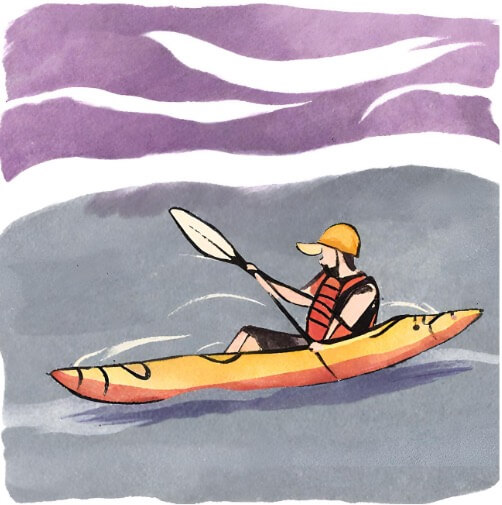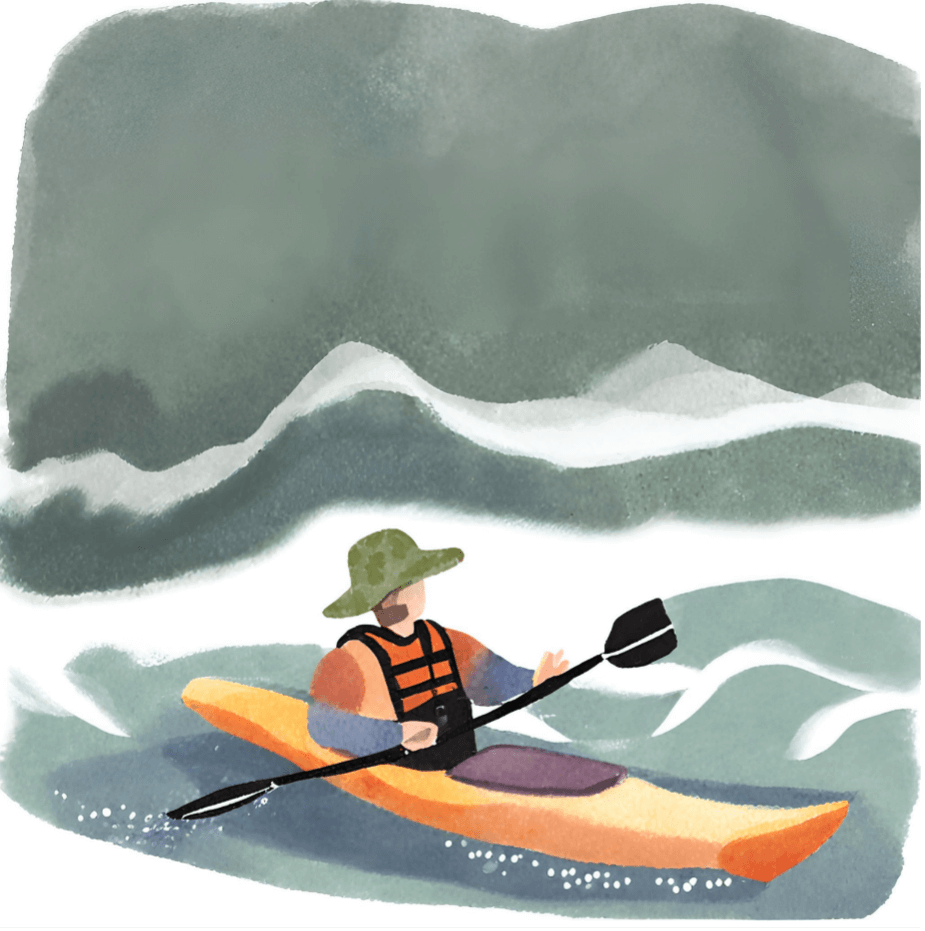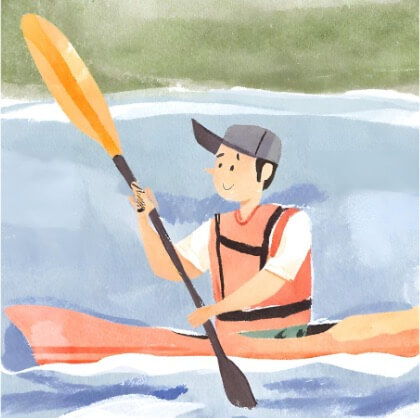Learning how to roll a kayak is an essential skill for kayaking enthusiasts, offering a way to quickly recover from a capsize. This maneuver, once known as the “Eskimo roll,” allows the paddler to right themselves without exiting the craft. It requires a synchronized combination of body movements and paddle actions to flip the kayak from an upside-down position back into its upright orientation.

Mastering the kayak roll enhances safety and boosts confidence when handling challenging paddling conditions. For those new to the sport, gaining a solid understanding of kayaking basics is a crucial first step. It is a skill best acquired through practice in calm, controlled environments before attempting in more dynamic waters. Alongside the technique, having the right gear further equips paddlers for successful rolling.
Key Takeaways
- Mastering the kayak roll is crucial for safety and confidence on the water.
- It’s important to practice in a calm environment with the proper gear.
- Knowledge of kayak dynamics aids in performing an effective roll.
Understanding Kayak Dynamics

Before attempting to roll a kayak, it’s essential to grasp how the design of the boat, the paddler’s positioning, and the water environments all interact to influence stability and maneuverability.
Boat Design and Stability
A kayak’s design has a profound effect on its stability. Primary stability refers to the initial steadiness a paddler feels when sitting upright in a flat-water environment. Secondary stability, on the other hand, comes into play during a roll or when navigating rough waters. For example, kayaks with a rounded or V-shaped hull will generally have better secondary stability, aiding in a successful roll, as discussed in this Kayak Odyssey article.
Paddler Positioning
Proper paddler positioning is crucial for a successful kayak roll. One must maintain a low center of gravity with their weight centered in the kayak. The paddler’s hips are pivotal in executing the roll, as they help in righting the boat through what’s called a “hip snap”. The body mechanics play a significant role, further explained in this guide by Kayak Odyssey.
Water Environments
Different water environments pose unique challenges for rolling a kayak. Calm waters provide an ideal setting for beginners to practice while moving waters or whitewater requires experienced techniques for maintaining control. The C-to-C roll, for instance, is preferred in whitewater conditions as it is fast and effective in tight spaces, a technique outlined in Boating Beast’s guide.
Essential Gear for Kayak Rolling

When learning to roll a kayak, having the right gear is critical for safety and effectiveness. The two main components to consider are the paddle and safety equipment.
Paddle Types
A proper paddle can make a significant difference in performing a roll. Here are some characteristics to look for:
- Blade Shape: A sweep roll is often easier with paddles that have a larger blade surface area, which provides more water resistance for support.
- Material and Weight: Lighter materials such as carbon fiber or fiberglass provide ease in maneuverability but can be more expensive. Heavier materials like plastic or aluminum may be more durable and cost-effective.
Safety Equipment
Safety should never be overlooked. Key safety items include:
- Kayak Helmet: It shields the head from impacts with the kayak or underwater obstacles. Make sure it fits securely.
- Personal Flotation Device (PFD): A PFD is essential for buoyancy and should always be worn. It also provides extra body support during a roll.
- Nose Plugs or Mask: To prevent water from entering the nose, nostril protection is helpful, especially when practicing.
Remember, the gear should complement personal comfort and skill level to ensure a safe and successful kayak roll.
The Rolling Technique
Mastering the kayak roll is essential for a paddler’s safety and confidence. It enables one to right their kayak if they’ve capsized without exiting their boat. The technique relies on coordinated movements and proper form.
Hip Snap Drill
The hip snap is crucial to every kayak roll. A paddler practices this by stabilizing their kayak alongside a dock or with the help of a partner. They’ll then lean into the water and swiftly snap their hips to right the kayak, keeping their head down to follow the body’s rotation.
Sweep Roll
The sweep roll involves a wide, sweeping motion with the paddle while using the hip snap to bring the kayak upright. The paddler starts by setting the paddle parallel to the kayak on the side they intend to roll, sweeping it outwards in a wide arc as they execute the hip snap.
C-to-C Roll
In the C-to-C roll, one begins by tucking forward and setting the paddle next to the kayak. They perform a sweeping motion to one side while executing a C-shaped path with their body, followed by a forceful hip snap, creating a secondary C-shape to bring the boat upright.
Pawlata Roll
The Pawlata roll, also known as the extended paddle roll, requires extending one’s paddle for greater leverage. The paddler holds the paddle with one hand at the blade’s base and the other at the opposite end of the shaft, using this extended reach to aid in rolling the kayak upright.
Practicing the Roll
Mastering the kayak roll demands patience, practice, and proper technique. One gradually builds up from dryland exercises to controlled environments like pools before finally taking to open waters.
Dryland Practice
Dryland drills are essential in building muscle memory without the added complexity of being in the water. Kayakers can use a paddle or broomstick to rehearse the hip snap, which is a fundamental part of the roll. They can sit on the floor with legs bent, and practice moving the hips while keeping their upper body as still as possible.
Pool Sessions
After gaining some confidence on land, the next step is to move to a pool for a safer and more controlled water environment. Here, kayakers can practice rolling with the assistance of an instructor or experienced kayaker. These sessions often involve repetitive practice of wet exits and re-entries, as well as executing the roll in still water.
Open Water Progression
Once comfortable in a pool setting, kayakers transition to open water to test their skills in more realistic conditions. It’s important that they pick calm, shallow waters and have a spotter for safety. They should apply what they learned during dryland and pool sessions, fine-tuning their roll in various water conditions and scenarios.
Frequently Asked Questions
What are the steps to performing a basic kayak roll?
To perform a basic kayak roll, one starts by setting up with the paddle positioned parallel to the kayak. They then execute a hip snap to right the kayak while using the paddle for support. Check out this video by whitewater kayak instructor Anna Levesque for a visual demonstration of how to roll a kayak.
Where can I find kayak rolling classes in my area?
One may find local kayak rolling classes by checking with nearby outdoor recreation stores, local kayak clubs, or community aquatic centers. Online directories and forums dedicated to kayaking can also be useful resources.
What’s the difference between a sweep roll and a C-to-C roll?
The sweep roll involves a sweeping motion of the paddle across the water surface for momentum, while the C-to-C roll is characterized by a ‘C’ shaped motion of the paddle and is generally considered faster and suitable for tight spaces.
Are there specific exercises to improve my kayak rolling technique?
Yes, exercises like practicing a hip snap on dry land, building core strength, and improving flexibility can all contribute to a better kayak rolling technique. Check out this article by ACE Sports Medicine on exercises that help to strengthen your kayaking roll technique. Paddlers often utilize pools or calm water to practice the motions in a controlled environment.
Is it possible to self-teach a kayak roll, and if so, how?
Self-teaching a kayak roll is possible, especially with the aid of instructional videos and books. However, having a spotter or instructor when in the water is advisable for safety and to provide immediate feedback on one’s technique.
What techniques are there for rolling a whitewater kayak?
Rolling a whitewater kayak involves techniques like the C-to-C roll, screw or sweep rolls, and the back deck roll, each suited to different scenarios and levels of paddler agility and experience in rough water contexts.
